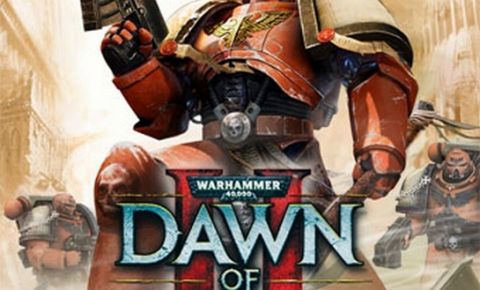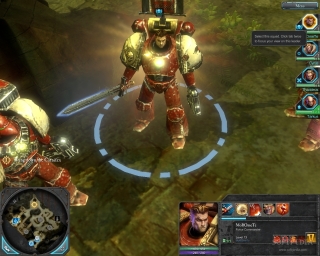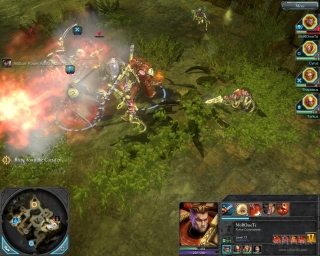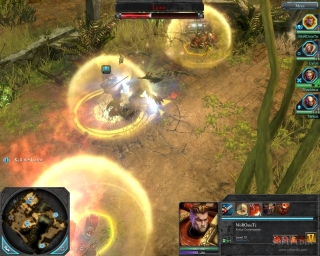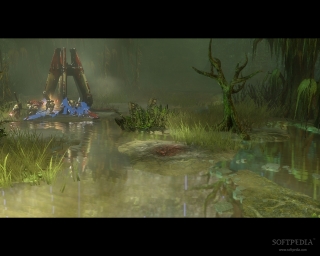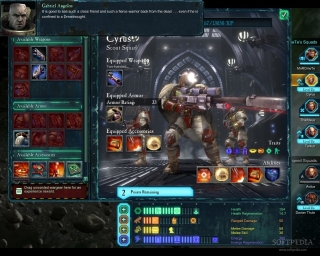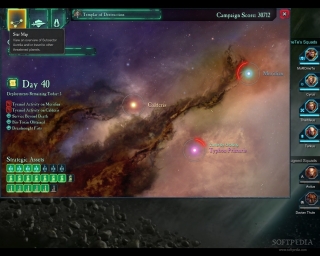You have to appreciate Relic’s guts. In the original Dawn of War, it had a beautiful game, which generated three successful expansion packs, played nice in multiplayer, provided epic battles and was quickly enshrined in the Hall of Fame of RTS games. It had it all: base building, teching up, a lot of unit types, a lot of factions, an overall strategic map in the final releases, wargear for commanders, and scripted missions for the toughest challenges. Relic could have easily taken all of the above, added a cover system a la Company of Heroes and a graphical upgrade and sell it as Dawn of War II. Sales would have been great.
Instead, the developer decided to take a radical approach to the franchise. There's little (in multiplayer) to no (in single player) base building. You usually have about 12 guys to command and the objectives are built upon eliminating enemy commanders, destroying clusters of buildings or just making it out alive of hairy situations. There are definite class progression elements, with experience points being distributed, gear being chosen and abilities evaluated. It can all be summed up in one phrase like this “Dawn of War II is a real tactics title with strategic elements and a level cap.” And the great thing is that, as weird as it sounds, the concept works beautifully.
Gameplay
The big question that arises for the reviewer is “Can Dawn of War II be classed as a RTS?” After all, there's no base building, there's no rushing, no huge mobs of impossible to distinguish units and no teching up. Instead, you get a game full of choices, all of which are important and all of which can change the way your experience in Dawn of War II.
There's no base building in the game. You never get to direct more than four squads of Space Marines. There are no “real” resources, although on the strategic level, you need to take into account three types of structures. The enemy is well organized, much more numerous and always has quite a few of surprises. About the only thing that Dawn of War II takes from its predecessor is the Warhammer 40,000 setting, with its dark tone and utter contempt for life, be it human or alien.
The decisions in the game are ever present. Whom do you leave out of combat? The Scouts, although they can snipe enemies and move stealthily? The Tactical Marines, good all around and able to use flamers and bolters? The Assault Marines, with their vertical assault ability and their close quarter power? The Devastator Squad, who can lay suppressing fire and slow all enemies down? I personally tend to leave out the Devastators, but I can easily see myself playing through another time in order to try out other tactics and deployments.
All squads progress as they gain experience in missions. There are four disciplines in which you can upgrade them. At certain moments, you unlock new traits for the different squads, making them more capable in the various tactical roles they can fill. You can also personalize the squads using wargear, which is basically loot for the space age. The different missions you get require you to customize your load out accordingly (remember to get Melta Bombs if there's any chance to face a vehicle).
The campaign is non linear. There are three planets and you can do one mission a week (more in some special circumstances). Some missions need to be performed in order to advance in the story, while others are side missions and can only be taken for just a narrow window of the game's time. Choose wisely, based on the rewards that you can receive (defense missions against Tyranids are rather tough).
The missions themselves are very tactics oriented. Secure all structures, as the benefits are worth it. Scout before engaging, as knowing what the enemy has is crucial in deciding how to approach the situation. The classic RTS tactic of grouping all units and go all in using abilities and choosing targets doesn't work (unless you're winning to revive a lot of commanders) so find cover, deploy suppressive fire, use stealth, prepare the battlefield with a turret or some mines and then engage. The engagements can be a bit repetitive at some time, but in the heat of battle, you'll hardly notice that you fight the same enemies over and over. The situation (terrain, cover or lack of it, available abilities) changes enough to make each fight engaging. In all missions, there's a boss that needs to be treated with respect and with a lot of firepower. There are also some missions where you need to search and destroy for some enemy structures. Just make sure that you always have a reinforcement point somewhere near your squads.
The boss fights are engaging but Relic gave some of them way too much health for the sake of the game. The rinse and repeat mode of assaulting them, using special abilities and then retreating to replenish health can be annoying. The best of them were those bosses that brought out other smaller squads to fight for them.
One of the issues with the campaign is the fact that the maps used on the three planets are rather limited in number. So, you get a feeling of trading the same ground. A little more variations would have been nice but it can be forgiven taking into consideration all the other things that vary in the game world. Another problem is the cover mechanics, which can, at some points, leave some of your guys exposed, even if all the visual aids lead you into believing you've got heavy cover.
One nice touch from Relic is the debriefing screen. There, you get rated, based on how many enemies you killed, how well you preserved your force and how quickly you completed your missions. Believe me, this leads to frustration when you get rated low and the determination to play through the game again to be better at it. It's a very nice addition aimed at the obsessive compulsive side of all gamers.
Visuals and audio
The Essence 2.0 engine manages to make the grim world of Warhammer 40,000 come to life. Environments are destructible, cover can be taken out, explosions are satisfying, movement precise. Some of the synchronized kill animations (please take the time to zoom in) are truly spectacular, especially the ones pulled off by the Tyranid bosses and the Force Commander. If there's one thing that annoys me is that the whole presentation feels at times just a bit too brightly colored, dulling the brutality of the action, which is finely rendered by the engine. Truth be told, I played the game for up to nine hours in one sitting, so the fault might lie with me.
The sound is not as thoroughly engaging as the visual aspect of Dawn of War II. The gruff Marines can sound quite repetitive at times, especially when they drop into the combat zone. Combat sounds are alright, even though some weapons seem to lack (audio) punch.
What's very well put together are the dialogues between the various missions. Squad leaders talk about the Chapter they belong to, why they keep fighting and how the Tyranids threaten the entire sentient life of the galaxy. They are unobtrusive, meaning that you can take care of the squad load out while listening to them, and succeed in offering a player a background on the Warhammer 40,000 universe and a reason for the actions that they undertake as the Force Commander. Other reviewers have said that the delivery is bland and base line, but in my view, the lore of the Space Marines demands a limited emotional range for them. The last semblances of humanity they retain beyond their looks are well emphasized by the voice actors and by the content of their conversations.
Some players are reporting a lot of crashes. Personally, I've had none and I'm running the game on full graphic setting on the highest resolution I can. There were some bugs with the campaign, but Relic moved quickly to squish them and more patches are likely incoming if more problems arise.
Multiplayer
This section of my reviews is most of the time short. One reason is the fact that I'm mainly a single player gamer. Another one is the fact that most games don't do anything new and interesting regarding multiplayer. The modes are there but they're not anything extraordinary, just extensions of the single player where the opponent is human. This is not the case with Dawn of War II. The Relic game is a very different beast in multiplayer.
There are no more stats that can be juggled on each of the squads. There are no more load outs that can be determined pre battle. There is still experience to be accumulated and squads level up as before but the accent is no longer on customization and load out but on quick tactical decision. In the single player missions, you can take your time to scout an enemy position and to deploy your forces slowly, achieving an overwhelming effect on the foes. In multiplayer, the emphasis is on moving quickly, staying tactically flexible and leveling up quickly to the third technology tier, where you can field powerful units that, adequately supported, will lead to victory. Otherwise, the stuff you've learned still applies: cover is crucial, stealth can be very powerful, using special abilities and global powers when they are really needed can mean the difference between victory and defeat. And control of resource nodes is crucial in multiplayer, so don't forget to constantly cap points.
In multiplayer, you can play as all the four factions (Space Marines, Eldar, Ork, Tyranids) and each side has three commanders, each suited to one style of play: one for brute force, a support commander and a stealth oriented one. Also, for each hero, you can choose gear while in the games, ranging from armor and weapons to grenades and teleporters. This means that there are a lot of variables a player can try out and that the multiplayer games are very diverse and unpredictable affairs.
For now, I would suggest sticking with LAN games, as the ranked element of the multiplayer requires use of a Games for Windows Live online enabled account, which implies a lot of Microsoft contact I am not comfortable with, some pretty weird match making and quite a lot of dropped matches (this could also be a fault of the game but blaming Microsoft and its products is an easier and safer bet). I consider playing with friends (2 vs 2 matches, using most six player maps) a much more interesting experience than slugging it out in ranked matches for the illusory reward of going up in ranks as I win matches.
The critique that can be leveled at the multiplayer section of Dawn of War II is that seven maps are not enough for the more hardcore gamers. I agree with the developers that the games are significantly different in how they play to make for enough variation, at least for the first month, but Relic needs to make some more maps available via DLC as quick as possible to slate the thirst of gamers who like multiplayer action. There's also the slight problem of having an overpowered side in the Tyranids (watch out for those Venom Cannons).
Conclusion
With Dawn of War II, Relic basically delivered two games. On the one hand, there's a single player experience that has soul, offers some tough tactical puzzles, while making the player care for his squads and also forces gamers to balance elements like side missions, gear, stats upgrades and combat roles. On the other hand, the game offers a fast and deep multiplayer mode, complete with its own set of choices and with its own dynamic. Both experiences are great and putting them in a single game makes Dawn of War II a title that redefines its genre (can we still call it Real Time Strategy?) while also delivering a polished, complete, deep gameplay experience. Just remember to play the game on one of the two top difficulty settings in order to get the most out of the experience, which means failing a little on the way to ultimate victory for the Emperor.
 14 DAY TRIAL //
14 DAY TRIAL // 